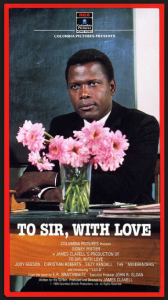The death of To Sir, With Love author E.R. Braithwaite, prompts David Linton to critique the iconic menstrual-pad-burning scene
 Sadly, not every novelist who has included menstrual references in the stories being told has done so in a positive, or even a neutral, fashion. In fact, in some cases the negative, stigma-ridden nature of such elements has been, at least by today’s standards, shockingly nasty. This observation is prompted by the posting of the obituary of E.R. Braithwaite, a diplomat, teacher, and author who died on December 12, 2016, at the age of 104. Perhaps a look back at his most well-known and popular novel, To Sir, With Love (1959) can be seen as an indication of progress in the public presentation of menstruation.
Sadly, not every novelist who has included menstrual references in the stories being told has done so in a positive, or even a neutral, fashion. In fact, in some cases the negative, stigma-ridden nature of such elements has been, at least by today’s standards, shockingly nasty. This observation is prompted by the posting of the obituary of E.R. Braithwaite, a diplomat, teacher, and author who died on December 12, 2016, at the age of 104. Perhaps a look back at his most well-known and popular novel, To Sir, With Love (1959) can be seen as an indication of progress in the public presentation of menstruation.
Braithwaite was born in Georgetown, British Guyana in 1912 and served in the prestigious British Air Force during World War II. The semi-autobiographical story he tells in To Sir is that of a black man’s struggle to fit into post-war British society. He takes a job teaching in a tough, working class neighborhood where, following a series of challenges to his authority – and to his manhood – he eventually wins over the unruly kids. The book remains a staple of adolescent literature and nearly sixty years after its publication it can still be found on the shelves of local bookstores.
 However, its continuing popularity is surely owed in part to the performance of the screen star Sidney Poitier in the movie of the same name in 1967. Poitier embodies notions of masculine dignity and strength – not to mention the fact that he’s a sexy guy – who demonstrated similar traits in other films of racial conflict that were released the same year: Guess Who’s Coming to Dinner and In the Heat of the Night.
However, its continuing popularity is surely owed in part to the performance of the screen star Sidney Poitier in the movie of the same name in 1967. Poitier embodies notions of masculine dignity and strength – not to mention the fact that he’s a sexy guy – who demonstrated similar traits in other films of racial conflict that were released the same year: Guess Who’s Coming to Dinner and In the Heat of the Night.
However, the novel and the film adaptation are severely flawed when it comes to the central plot element involving references to menstruation. In fact, both symbolically and literally, the entire story turns on a used menstrual pad. The teacher was having a hard time gaining control of his classroom and one day after a recess he entered the room to find a haze of smoke in the air and a foul stench. Upon opening the grate of the heater he discovered a smoldering napkin. His reaction encapsulates a wealth of meaning about gender, respect and notions of propriety:
I was so overcome by anger and disgust that I completely lost my temper. I ordered the boys out of the room, then turned the full lash of my angry tongue on those girls. I told them how sickened I was by their general conduct, crude language, sluttish behavior, and of their free and easy familiarity with the boys. The words gushed out of me, and the girls stood there and took it. By god, they took it. “There are certain things which decent women keep private at all times.… Only a filthy slut would have dared to do this thing.… I expect that disgusting object to be removed and the windows opened to clear away the stink … if you must play these dirty games, play them in your homes, but not in my classroom.“
This passage is from the text of the novel itself but it was repeated almost verbatim in the movie as well. There is a wealth of psychological material here that readers are invited to delve into. Among the many significant cultural elements are the facts that such a passage is unlikely to find its way into a popular book for adolescents today and that throughout its decades of popularity this aspect of the novel has never received critical attention. Furthermore, the presumption the teacher makes that a girl was responsible for this prank strikes me as unwarranted. The boys in the class were much more likely to find such a way to test the teacher’s authority by forcing him to confront a smoking menstrual rag, but his own menstrual avoidance made it impossible to even consider such an act.
It is regrettable that the author was never asked to reflect on this element in his book. Perhaps someone could find an opportunity to ask Sidney Poitier, who is still alive, how they decided to treat the scene in the course of its filming.
David Linton is an Emeritus Professor at Marymount Manhattan College. He is also Editor of the SMCR Newsletter and a member of the Menstruation Matters editorial board. His research focus is on media representations of the menstrual cycle as well as how women and men relate to one another around the presence of menstruation.

